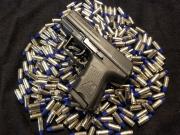First, thank you all very much, P-F.com members and TLG. The advice given in the original thread was spot on. Original thread:
http://pistol-forum.com/showthread.p...udent-question
The student and I went our separate ways after the last session, both feeling like little progress was made. He contacted me for another range session (I do not charge anything) after he went shooting with some friends and shot the most classic "comet" pattern you've ever seen. I mean, he shot probably 30ish rounds and the tail of the "comet" was pointing almost directly at the 7:30 position. He had emailed me a picture of the target, so diagnosis was simple.
We agreed upon a date/time to link up and I started my planning process to confirm my diagnosis and isolate the problem. I'm not going into the boring details, but I wanted to have a game plan from the start and this was different from my usual "Intro to handguns" classes.
What I settled on was using a variation of one of TLGs drills, essentially using a 9 inch paper plate modified with HeadHnter6's CD paint plan for the target. Distance was 7 yards, start was from the ready with the shooter firing 5 shots AFAP. Accuracy standards were 100 %, time being recorded for evaluation and (hopefully) progression.
(Slight detour. Reading the AARs here and doing some research into adult learning theory, I noted that having a baseline for the shooter allows both the instructor and student to track progression (or lack there of).)
I took my S&W M&P .45 for us to have our initial evaluations on a shared platform and a relatively harder recoiling pistol. More about that, later.
His first 100% run was at 5.23 seconds. Mine was considerably faster, so I had my edge going forward. But a funny thing happened. He had a couple of trigger jerks throwing his shots off the paper plate, but settled right down and IIRC, his second run was his 100% run. We switched up targets and firearms. I had him do some ball and dummy drills with my 617 and he did OK. Certainly not what I thought he would do as I had him firing DA only with the .22. I mentioned that perhaps the lack of recoil was helping. He remarked that his carry gun (compact .40) had much more recoil than my .45.
Full stop. Holy cow. No way.
We set the original drill back up and I shot the COF with his handgun. I'm not going to mention brand, but it's one I have little experience with and I don't do a lot of .40 shooting either. But still, it's a 10mm Short, so how could it kick more?
I was wrong.
That was one of the most irritating handguns I have ever fired. He wasn't milking his grip as I had first thought, the darn pistol was the challenge. Due to the short grip and "torquey" recoil, the grip was getting pulled through my palm. I have a hard grip and fairly strong hands. Still, it was a challenge for me to stay under 3 seconds. I did have to regain my grip after a couple of rounds. My observation and initial conclusion was flawed as I thought he was adjusting his grip for every shot. What I had concluded was fundamentally wrong. He wasn't adjusting, he was re-gaining his grip.
OK then. Time to change up the game plan.
To make a long story short, we adjusted some of his stance so that he put more grip pressure on the pistol and his control was markedly better. Running that quick and simple drill (but not often) allowed us to generate data that what I was teaching was working. Stole that idea right from TLG.
To sum up, IMHO, this was a bit of an anomaly. The equipment was the issue, which is fairly counter to my experience. My initial mistake, both sessions, was not actually evaluating his firearm & ammo, even though I'd never fired that model. I also confused cause and effect. Lesson learned.
Good side of the story (we all love a happy ending) was that the student progressed and when he fired my 9mm compact, he shot considerably better. Like shoes or hats, getting the size right is fairly important. Having a standard to track progress really let this student integrate and participate in his training. I think that's important.





 Reply With Quote
Reply With Quote





